Watchful Dreamer: The Subversive Melancholia of Helmut Käutner is the name of Il Cinema Ritrovato's section about one the most influential and acclaimed directors of German post-war cinema. Helmut Käutner (1908-1980) already began his career as an actor and cabaret artist at the end of the Weimar Republic and he directed his first major films in Nazi Germany. Programma curator Olaf Möller describes him as "a radical of modesty and moderation, an ironic modernist of melancholia, an inventor of cinematic forms, an avant-gardist of the popular." It makes us curious about this section.
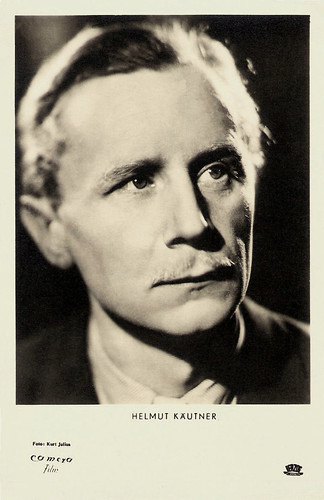
Helmut Käutner. German postcard by Photo-Kitt, München, no. 504. Photo: Kurt Julius / Camera Film.
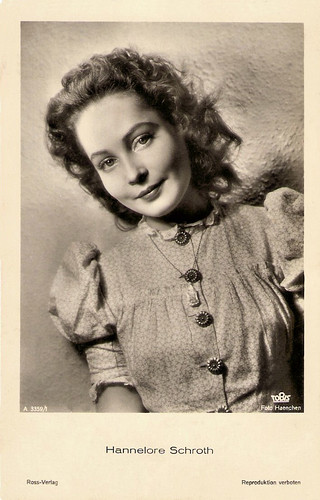
Hannelore Schroth. German Postcard by Ross Verlag, no. A 3359/1, 1941-1944. Photo: Haenchen / Tobis.
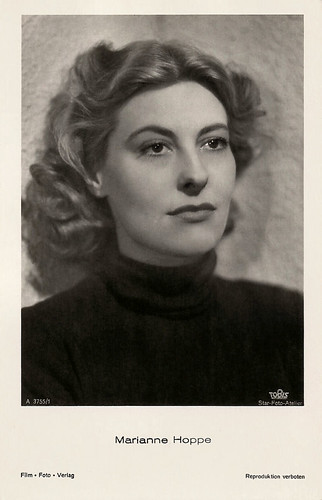
Marianne Hoppe. German postcard by Film-Foto-Verlag, no. A 3755/1. 1941-1944. Photo: Star-Foto-Atelier / Tobis.
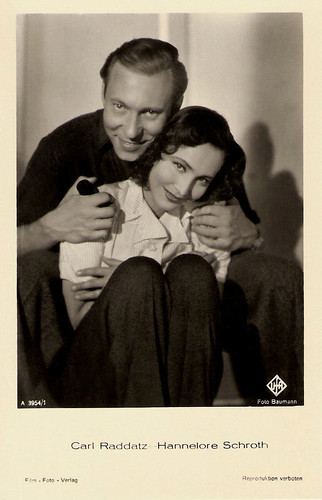
Carl Raddatz and Hannelore Schroth. German postcard by Film-Foto-Verlag, no. 3954/1, 1941-1944. Photo: Baumann / Ufa.

Fritz Wagner. German postcard by Kitt Fotokarten / Photo Kitt, München, no. 527. Photo: Kurt Julius / Camera Film / Herzog. Publicity still for In jenen Tagen/Seven Journeys (Helmut Käutner, 1947).
Paul Günther Helmut Käutner was born in 1908 in Düsseldorf, Germany. He was the son of merchant Paul Läutner and his wife Claire, born Röntgen. In 1916, the family moved to Essen where Käutner attended Helmholtz-Realgymnasium and participated in school theatre performances. He studied graphics, costume design, set design, and interior design at the Kunstgewerbeschule. In 1928, he went to Munich's university to study German studies, philosophy, psychology, art history, and theatre studies. From 1931 to 1935 he wrote, directed and performed at the Munich Student Cabaret troupe Die vier Nachrichter (The Four Executioners). The literary and rather unpolitical group was banned in 1935 for "lack of reliability and aptitude according to national socialist governance". Käutner wrote feuilletons and reviews for the Bavarian University newspaper.
In 1932, he made his film debut as an actor in Kreuzer Emden/Cruiser Emden (Louis Ralph, 1932), but after that experience, he turned to the theatre again and also wrote songs. From 1936 to 1938 he worked as an actor and director at the Schauspielhaus in Leipzig, at the Kammerspielen in Munich, at the Theater am Schiffbauerdamm, at the Komödie and at the Kabarett der Komiker in Berlin. In 1938 he drew attention to himself as a screenwriter for such films as Schneider Wibbel/Wibbel the Tailor (Victor de Kowa, 1938), Salonwagen E 417/Parlour Car E 417 (Paul Verhoeven, 1938), Die Stimme aus dem Äther/The Voice from the Ether (Harald Paulsen, 1938) and Marguerite: 3/Marguerite Divided by Three (Theo Lingen, 1938).
In 1939 Käutner began his career as a film director with the light-hearted comedy Kitty und die Weltkonferenz/Kitty and the World Conference (1939), featuring Hannelore Schroth. Käutner was not a member of the resistance but, during the period of National Socialism, he was able to maintain a certain independence in his work. Kitty and the World Conference was withdrawn by the Nazi censors due to its “pro-English tendencies”. Käutner rejected the UFA filmmaking establishment and produced thoughtful and poetic works like Kleider machen Leute/Clothes Make the Man (1940) starring Heinz Rühmann, Auf Wiedersehen, Franziska!/Goodbye, Franziska! (1941), and Romanze in Moll/Romance in a Minor Key (1943) starring Marianne Hoppe and Paul Dahlke. The latter was often seen as Käutner’s best film of this period. Romanze in Moll is an adaptation of Guy du Maupassant’s short story Les Bijoux. A somewhat traditional love triangle story, the film was praised for its compositional perfection and technical virtuosity.
Käutner’s films considered the struggles of the German people during a period of great turmoil. With Große Freiheit Nr. 7/Great Freedom No. 7 (1944) with Hans Albers, and Unter den Brücken/Unter the Bridges (1945) with Hannelore Schroth and Carl Raddatz, he created two films which, in their emphasis on the individual, strongly opposed the world view of the national socialists.
Käutner’s work was noted for its more humanistic depiction of daily life than his contemporaries. Große Freiheit Nr. 7 is a melancholy, bittersweet story of disappointed love set amongst the sailors' clubs and bars of the Hamburg waterfront. The film title, which refers to a street next to Hamburg's Reeperbahn road in the St. Pauli red light district, caused a furore among the Nazis who feared that audiences would misinterpret the film’s meaning. As a result, the film was banned in Germany until the fall of the Third Reich. Unter den Brücken, which is set amongst the bargees of the River Havel, is now considered one of the greatest love stories in the history of German cinema. Käutner’s avoidance of overt political content in his films during the war, allowed him to continue his career unhindered after 1945.
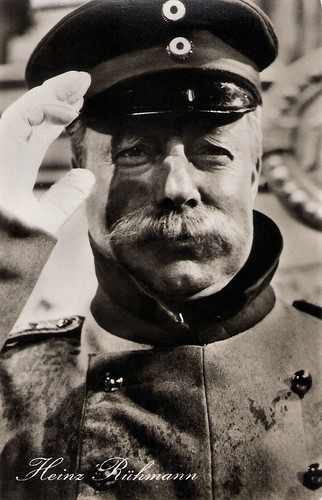
Heinz Rühmann. East-German postcard by VEB Progress Film-Vertrieb. Berlin, no. 309. Photo: Real-Film. Publicity still for Der Kaufmann von Köpenick/The Captain from Köpenick (Helmut Käutner, 1956).
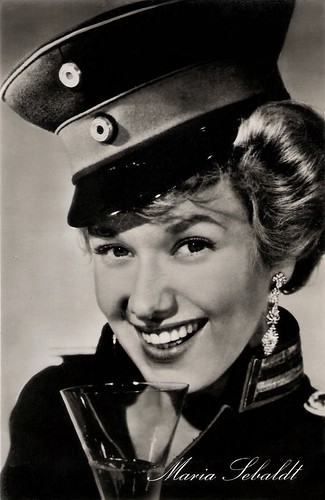
Maria Sebaldt. East-German postcard by VEB Progress Film-Vertrieb. Berlin, no. 321. Photo: Real-Film. Publicity still for Der Kaufmann von Köpenick/The Captain from Köpenick (Helmut Käutner, 1956).
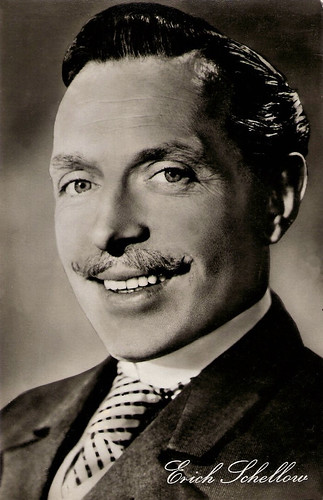
Erich Schellow. East-German postcard by VEB Progress Film-Vertrieb, Berlin, no. 312, 1957. Photo: Real Film. Publicity still for Der Hauptmann von Köpenick/The Captain from Köpenick (Helmut Käutner, 1956).
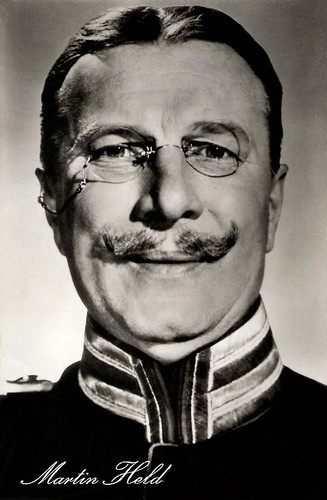
Martin Held. East-German postcard by VEB Progress Film-Vertrieb. Berlin, no. 311. Photo: Real-Film. Publicity still for Der Kaufmann von Köpenick/The Captain from Köpenick (Helmut Käutner, 1956).

Walter Giller. German postcard by Ufa/Film-Foto, Berlin-Tempelhof, no. FK 3206. Photo: Gabriele / Real Film / Europa. Publicity still for Der Hauptmann von Köpenick/The Captain from Koepenick (Helmut Käutner, 1956).
In 1947 Helmut Käutner made the first German film after WWII, the Trümmerfilm In jenen Tagen/In Those Days (1947) with Gert E. Schäfer, Erich Schellow and Winnie Markus. The film describes the post-war reality of people overwhelmed and traumatised by the impact of fascism. It was a great success and launched a new German film. Käutner used the framing device of an automobile whose various owners serve as the film’s protagonists and initiate its episodic structure.
In the next years, he directed such films as Der Apfel ist ab/The Original Sin (1948), Königskinder/Royal Children (1950), Epilog – Das Geheimnis der Orplid/Epilogue (1950) and Bildnis einer Unbekannten/Portrait of a Unknown Woman (1954). He was acclaimed for these socially conscious, often starkly realistic post-war films, which depicted the plight of the common man, struggling with the traumatic effects of the war and its aftermath. However, the films were no audience successes.
In 1954, he won the Prix International at the Cannes Film Festival for his stark, realistic anti-war drama Die letzte Brücke/The Last Bridge (1954). In the following years, he had great successes with Ludwig II: Glanz und Ende eines Konigs/Mad Emperor: Ludwig II (1955) and the Carl Zuckmayer adaptations Des Teufels General/The Devil’s General (1954), with Curd Jürgens, Der Hauptmann von Köpenick/The Captain from Kopenick (1956) with Heinz Rühmann, and Der Schinderhannes (1958), again with Curd Jürgens.In 1956, Der Hauptmann von Köpenick was nominated for the Oscar for Best Foreign Language Film at the 29th Academy Awards. Another international success was Monpti/Love from Paris (1957), starring Romy Schneider and Horst Buchholz. Käutner moved to Hollywood and produced two films for Universal: the family melodrama The Restless Years (1958) and A Stranger in My Arms (1959), with Charles Coburn and Sandra Dee.
He soon returned to West Germany and made Der Rest ist Schweigen/The Rest Is Silence (1959), a modern-day retelling of 'Hamlet', starring Hardy Krüger. Other interesting films were Das Glas Wasser/A Glass of Water (1960) and Schwarzer Kies/Black Gravel (1961).Käutner did not feel a connection with the Oberhausen Manifesto of 1962 or the New German Cinema, and he distanced himself more and more from the cinema. His final feature films were Das Haus in Montevideo/The House in Montevideo (1963) with Heinz Rühmann and Ruth Leuwerik, Lausbubengeschichten/Tales of a Young Scamp (1964), and the remake of Der Feuerzangenbowle/The Fire Tongue Bowl (1970), with Walter Giller and Uschi Glas.
He began to work for television and occasionally he appeared as an actor. In addition, he also increasingly directed for the theatre. In 1967, he received the Adolf-Grimme-Preis for his television production Surgical Interventions in the Soul Life of Dr. Igor Igorowitsch. In 1974 he played the title role in Hans-Jürgen Syberberg's feature film Karl May. Helmut Käutner also worked for Radio Hamburg. Since 1934, he had been married to the actress Erica Balqué who later was an assistant director for almost all his films. His last years of life, already seriously ill, he spent with his wife in Tuscany in his house in Castellina in Chianti, in the north of the province of Siena. There he died in 1980 at the age of 72.
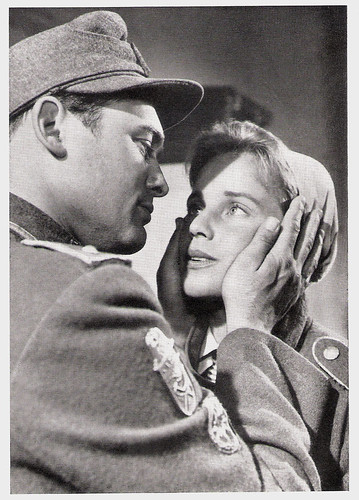
Maria Schell and Carl Möhner. German collectors card. Photo: publicity still for Die Letzte Brücke/The Last Bridge (Helmut Käutner, 1954).

West-German postcard by Kolibri-Verlag, no. 1400. Photo: Real / Europa Film-Verleih / Gabriele. Eva Ingeborg Scholz in Des Teufels General/The Devil's General (Helmut Käutner, 1955).
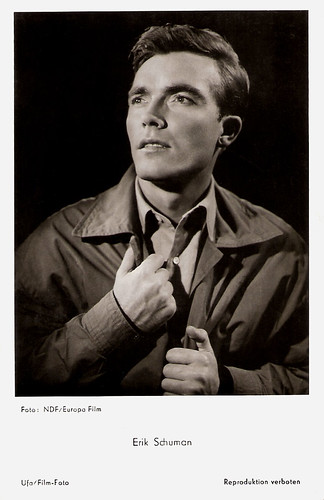
West-German postcard by Ufa/Film-Foto, Berlin-Tempelhof, no. FK 1920. Photo: NDR / Europa Film. Erik Schumann in Himmel ohne Sterne/Sky Without Stars (Helmut Käutner, 1955).
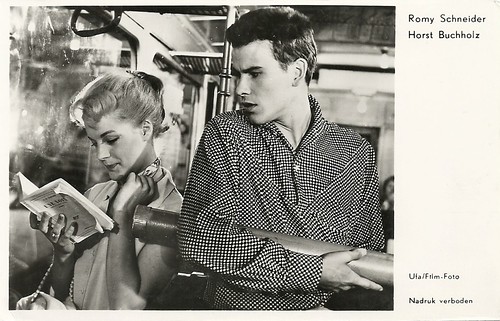
Romy Schneider and Horst Buchcholz. Dutch postcard by Gebr. Spanjersberg, Rotterdam, no. 1022. Photo: Ufa. Publicity still for Monpti (Helmut Käutner, 1957).
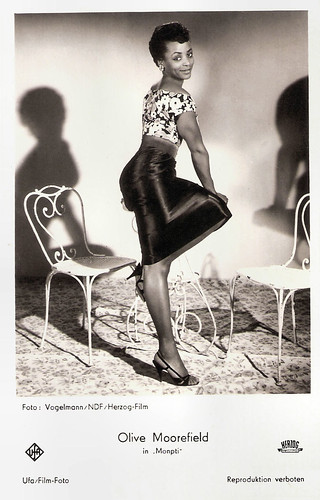
Olive Moorefield. German postcard by Ufa. Photo: Vogelmann / NDF / Herzog-film. Publicity still for Monpti (Helmut Käutner, 1957).
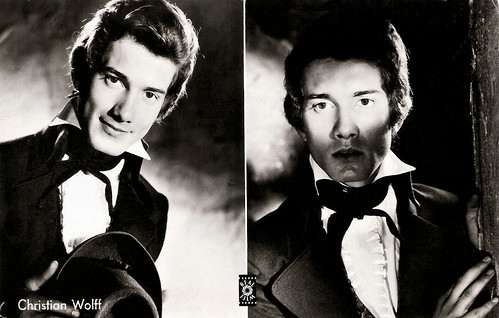
Christian Wolff. German postcard by Rüdel-Verlag, Hamburg-Bergedorf, no. D 2548. Photo: Real / Europa / Gabriele. Publicity still for Der Schinderhannes/Duel in the Forest (Helmut Käutner, 1958).
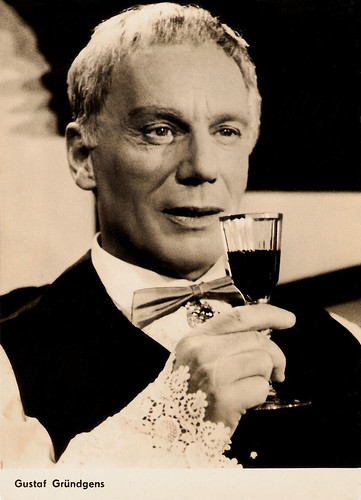
East German postcard by VEB Progress Film-Vertrieb, Berlin, no. 2.049, 1964. Photo: Gustaf Gründgens in Das Glas Wasser/A Glass of Water (Helmut Käutner, 1960).
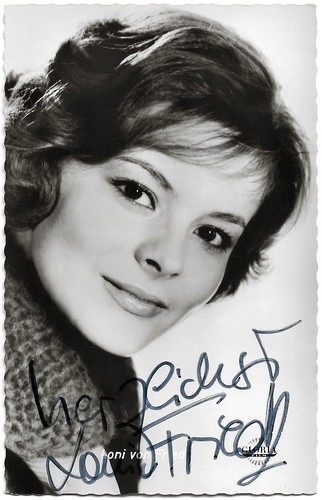
West German postcard by Kolibri-Verlag G.m.b.H., Minden/Westf, no. 1596. Photo: Gabriele / Alfa / Gloria Film. Loni von Friedl in Zu jung für die Liebe/Too young for love? (Erica Balqué, Helmut Käutner, 1961).
Sources: Julian Petley (Film Reference), Filmportal, Harvard Film Archive (Page now defunct), Encyclopædia Britannica, Wikipedia (English and German), and IMDb.
This post was last updated on 7 December 2024.

Helmut Käutner. German postcard by Photo-Kitt, München, no. 504. Photo: Kurt Julius / Camera Film.

Hannelore Schroth. German Postcard by Ross Verlag, no. A 3359/1, 1941-1944. Photo: Haenchen / Tobis.

Marianne Hoppe. German postcard by Film-Foto-Verlag, no. A 3755/1. 1941-1944. Photo: Star-Foto-Atelier / Tobis.

Carl Raddatz and Hannelore Schroth. German postcard by Film-Foto-Verlag, no. 3954/1, 1941-1944. Photo: Baumann / Ufa.

Fritz Wagner. German postcard by Kitt Fotokarten / Photo Kitt, München, no. 527. Photo: Kurt Julius / Camera Film / Herzog. Publicity still for In jenen Tagen/Seven Journeys (Helmut Käutner, 1947).
Pro-English tendencies
Paul Günther Helmut Käutner was born in 1908 in Düsseldorf, Germany. He was the son of merchant Paul Läutner and his wife Claire, born Röntgen. In 1916, the family moved to Essen where Käutner attended Helmholtz-Realgymnasium and participated in school theatre performances. He studied graphics, costume design, set design, and interior design at the Kunstgewerbeschule. In 1928, he went to Munich's university to study German studies, philosophy, psychology, art history, and theatre studies. From 1931 to 1935 he wrote, directed and performed at the Munich Student Cabaret troupe Die vier Nachrichter (The Four Executioners). The literary and rather unpolitical group was banned in 1935 for "lack of reliability and aptitude according to national socialist governance". Käutner wrote feuilletons and reviews for the Bavarian University newspaper.
In 1932, he made his film debut as an actor in Kreuzer Emden/Cruiser Emden (Louis Ralph, 1932), but after that experience, he turned to the theatre again and also wrote songs. From 1936 to 1938 he worked as an actor and director at the Schauspielhaus in Leipzig, at the Kammerspielen in Munich, at the Theater am Schiffbauerdamm, at the Komödie and at the Kabarett der Komiker in Berlin. In 1938 he drew attention to himself as a screenwriter for such films as Schneider Wibbel/Wibbel the Tailor (Victor de Kowa, 1938), Salonwagen E 417/Parlour Car E 417 (Paul Verhoeven, 1938), Die Stimme aus dem Äther/The Voice from the Ether (Harald Paulsen, 1938) and Marguerite: 3/Marguerite Divided by Three (Theo Lingen, 1938).
In 1939 Käutner began his career as a film director with the light-hearted comedy Kitty und die Weltkonferenz/Kitty and the World Conference (1939), featuring Hannelore Schroth. Käutner was not a member of the resistance but, during the period of National Socialism, he was able to maintain a certain independence in his work. Kitty and the World Conference was withdrawn by the Nazi censors due to its “pro-English tendencies”. Käutner rejected the UFA filmmaking establishment and produced thoughtful and poetic works like Kleider machen Leute/Clothes Make the Man (1940) starring Heinz Rühmann, Auf Wiedersehen, Franziska!/Goodbye, Franziska! (1941), and Romanze in Moll/Romance in a Minor Key (1943) starring Marianne Hoppe and Paul Dahlke. The latter was often seen as Käutner’s best film of this period. Romanze in Moll is an adaptation of Guy du Maupassant’s short story Les Bijoux. A somewhat traditional love triangle story, the film was praised for its compositional perfection and technical virtuosity.
Käutner’s films considered the struggles of the German people during a period of great turmoil. With Große Freiheit Nr. 7/Great Freedom No. 7 (1944) with Hans Albers, and Unter den Brücken/Unter the Bridges (1945) with Hannelore Schroth and Carl Raddatz, he created two films which, in their emphasis on the individual, strongly opposed the world view of the national socialists.
Käutner’s work was noted for its more humanistic depiction of daily life than his contemporaries. Große Freiheit Nr. 7 is a melancholy, bittersweet story of disappointed love set amongst the sailors' clubs and bars of the Hamburg waterfront. The film title, which refers to a street next to Hamburg's Reeperbahn road in the St. Pauli red light district, caused a furore among the Nazis who feared that audiences would misinterpret the film’s meaning. As a result, the film was banned in Germany until the fall of the Third Reich. Unter den Brücken, which is set amongst the bargees of the River Havel, is now considered one of the greatest love stories in the history of German cinema. Käutner’s avoidance of overt political content in his films during the war, allowed him to continue his career unhindered after 1945.

Heinz Rühmann. East-German postcard by VEB Progress Film-Vertrieb. Berlin, no. 309. Photo: Real-Film. Publicity still for Der Kaufmann von Köpenick/The Captain from Köpenick (Helmut Käutner, 1956).

Maria Sebaldt. East-German postcard by VEB Progress Film-Vertrieb. Berlin, no. 321. Photo: Real-Film. Publicity still for Der Kaufmann von Köpenick/The Captain from Köpenick (Helmut Käutner, 1956).

Erich Schellow. East-German postcard by VEB Progress Film-Vertrieb, Berlin, no. 312, 1957. Photo: Real Film. Publicity still for Der Hauptmann von Köpenick/The Captain from Köpenick (Helmut Käutner, 1956).

Martin Held. East-German postcard by VEB Progress Film-Vertrieb. Berlin, no. 311. Photo: Real-Film. Publicity still for Der Kaufmann von Köpenick/The Captain from Köpenick (Helmut Käutner, 1956).

Walter Giller. German postcard by Ufa/Film-Foto, Berlin-Tempelhof, no. FK 3206. Photo: Gabriele / Real Film / Europa. Publicity still for Der Hauptmann von Köpenick/The Captain from Koepenick (Helmut Käutner, 1956).
Prix International at the Cannes Film Festival
In 1947 Helmut Käutner made the first German film after WWII, the Trümmerfilm In jenen Tagen/In Those Days (1947) with Gert E. Schäfer, Erich Schellow and Winnie Markus. The film describes the post-war reality of people overwhelmed and traumatised by the impact of fascism. It was a great success and launched a new German film. Käutner used the framing device of an automobile whose various owners serve as the film’s protagonists and initiate its episodic structure.
In the next years, he directed such films as Der Apfel ist ab/The Original Sin (1948), Königskinder/Royal Children (1950), Epilog – Das Geheimnis der Orplid/Epilogue (1950) and Bildnis einer Unbekannten/Portrait of a Unknown Woman (1954). He was acclaimed for these socially conscious, often starkly realistic post-war films, which depicted the plight of the common man, struggling with the traumatic effects of the war and its aftermath. However, the films were no audience successes.
In 1954, he won the Prix International at the Cannes Film Festival for his stark, realistic anti-war drama Die letzte Brücke/The Last Bridge (1954). In the following years, he had great successes with Ludwig II: Glanz und Ende eines Konigs/Mad Emperor: Ludwig II (1955) and the Carl Zuckmayer adaptations Des Teufels General/The Devil’s General (1954), with Curd Jürgens, Der Hauptmann von Köpenick/The Captain from Kopenick (1956) with Heinz Rühmann, and Der Schinderhannes (1958), again with Curd Jürgens.In 1956, Der Hauptmann von Köpenick was nominated for the Oscar for Best Foreign Language Film at the 29th Academy Awards. Another international success was Monpti/Love from Paris (1957), starring Romy Schneider and Horst Buchholz. Käutner moved to Hollywood and produced two films for Universal: the family melodrama The Restless Years (1958) and A Stranger in My Arms (1959), with Charles Coburn and Sandra Dee.
He soon returned to West Germany and made Der Rest ist Schweigen/The Rest Is Silence (1959), a modern-day retelling of 'Hamlet', starring Hardy Krüger. Other interesting films were Das Glas Wasser/A Glass of Water (1960) and Schwarzer Kies/Black Gravel (1961).Käutner did not feel a connection with the Oberhausen Manifesto of 1962 or the New German Cinema, and he distanced himself more and more from the cinema. His final feature films were Das Haus in Montevideo/The House in Montevideo (1963) with Heinz Rühmann and Ruth Leuwerik, Lausbubengeschichten/Tales of a Young Scamp (1964), and the remake of Der Feuerzangenbowle/The Fire Tongue Bowl (1970), with Walter Giller and Uschi Glas.
He began to work for television and occasionally he appeared as an actor. In addition, he also increasingly directed for the theatre. In 1967, he received the Adolf-Grimme-Preis for his television production Surgical Interventions in the Soul Life of Dr. Igor Igorowitsch. In 1974 he played the title role in Hans-Jürgen Syberberg's feature film Karl May. Helmut Käutner also worked for Radio Hamburg. Since 1934, he had been married to the actress Erica Balqué who later was an assistant director for almost all his films. His last years of life, already seriously ill, he spent with his wife in Tuscany in his house in Castellina in Chianti, in the north of the province of Siena. There he died in 1980 at the age of 72.

Maria Schell and Carl Möhner. German collectors card. Photo: publicity still for Die Letzte Brücke/The Last Bridge (Helmut Käutner, 1954).

West-German postcard by Kolibri-Verlag, no. 1400. Photo: Real / Europa Film-Verleih / Gabriele. Eva Ingeborg Scholz in Des Teufels General/The Devil's General (Helmut Käutner, 1955).

West-German postcard by Ufa/Film-Foto, Berlin-Tempelhof, no. FK 1920. Photo: NDR / Europa Film. Erik Schumann in Himmel ohne Sterne/Sky Without Stars (Helmut Käutner, 1955).

Romy Schneider and Horst Buchcholz. Dutch postcard by Gebr. Spanjersberg, Rotterdam, no. 1022. Photo: Ufa. Publicity still for Monpti (Helmut Käutner, 1957).

Olive Moorefield. German postcard by Ufa. Photo: Vogelmann / NDF / Herzog-film. Publicity still for Monpti (Helmut Käutner, 1957).

Christian Wolff. German postcard by Rüdel-Verlag, Hamburg-Bergedorf, no. D 2548. Photo: Real / Europa / Gabriele. Publicity still for Der Schinderhannes/Duel in the Forest (Helmut Käutner, 1958).

East German postcard by VEB Progress Film-Vertrieb, Berlin, no. 2.049, 1964. Photo: Gustaf Gründgens in Das Glas Wasser/A Glass of Water (Helmut Käutner, 1960).

West German postcard by Kolibri-Verlag G.m.b.H., Minden/Westf, no. 1596. Photo: Gabriele / Alfa / Gloria Film. Loni von Friedl in Zu jung für die Liebe/Too young for love? (Erica Balqué, Helmut Käutner, 1961).
Sources: Julian Petley (Film Reference), Filmportal, Harvard Film Archive (Page now defunct), Encyclopædia Britannica, Wikipedia (English and German), and IMDb.
This post was last updated on 7 December 2024.
No comments:
Post a Comment